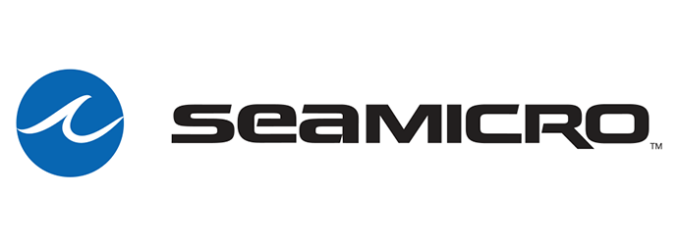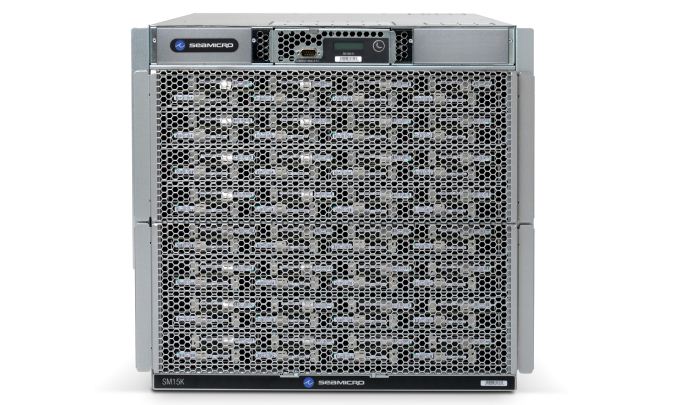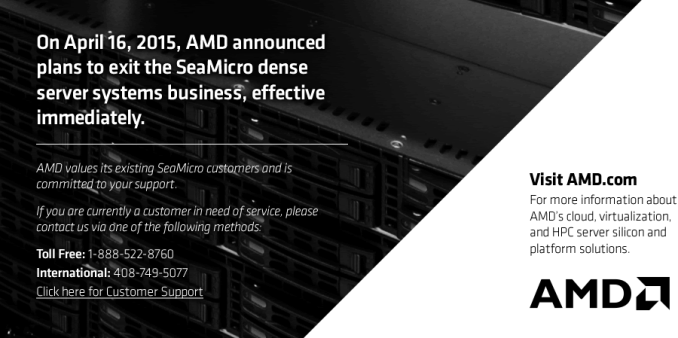AMD Exits Dense Microserver Business, Ends SeaMicro Brand
by Ryan Smith on April 16, 2015 5:30 PM EST- Posted in
- CPUs
- IT Computing
- AMD
- SeaMicro
- Microserver
- Servers

AMD’s Q1’15 earnings announcement just came out a bit ago, and while we’re still waiting for the analyst call to take place to get more details, there is one item we want to get to right away, and that’s the fate of AMD’s dense server business. As part of today’s earnings release, AMD has announced that they’re existing the dense server system business – operating under the SeaMicro brand – effective immediately.
AMD initially acquired SeaMicro back in 2012 for $334 million as part of their larger play into being an agile company, aiming to take a big chunk of what was expected to be a fast-growing market micro/dense server market. In the microserver model, servers are built using very large numbers of lower performance cores, making the servers leaner, more power efficient systems for tasks that involve large numbers of low-impact threads (think: web servers). This in turn mapped well to AMD’s processor designs, where both the Bulldozer and Cat families would be well suited for such a design, not to mention AMD’s future ARM based CPUs.
SeaMicro’s first product post-acquisition was the SM15000, a dense server design announced in late 2012 that offered either AMD “Piledriver” Opterons or Intel “Ivy Bridge” Xeon CPUs. However as it turns out that first design was also the last design; SeaMicro did not release any additional products prior to today’s announcement from AMD.
Jumping back to today, AMD’s announcement comes as the company is continuing to try to find a solid foothold as a semi-custom silicon company, to which it would appear that the SeaMicro business no longer fits into. AMD’s initial announcement does offer a bit of insight as to why they’re exiting the business – to “sharpen and simplify” what the company invests in – and we’ll likely hear more on today’s call.
Meanwhile it’s worth noting that we haven’t heard anything from SeaMicro in some time now, so today’s announcement is perhaps not all that surprising. Still, AMD’s first ARM processors were set to ship this year – the Opteron A1100 – which would have been a good fit for the SeaMicro servers. However A1100 itself appears to be behind schedule at this time, as AMD has yet to bring A1100 to market beyond last year’s development kit.
Anyhow, as part of exiting the dense server business, AMD will be taking a $75 million dollar special charge, which is “primarily related to impairment of previously acquired intangible assets” and will include a $7 million cash payment. Meanwhile AMD’s announcement doesn’t say what will become of the SeaMicro team – at this point we’re not entirely sure how large it is after AMD’s most recent restructuring – though I wouldn’t be surprised if they at least rolled some of that expertise into future ARM server CPUs. As for the SeaMicro brand itself, with AMD’s exit the brand has been shuttered, and AMD has deactivated the SeaMicro website.
Update: Here are the prepared remarks from AMD's CFO regarding SeaMicro
At the corporate level, we continue aligning larger portions of our R&D investments to take advantage of long-term growth opportunities across our EESC segment. As we prioritize our R&D investments and simplify our business, we made the decision in the first quarter to exit the dense server systems business as we increase investments in our server processor development. We retain the fabric technology as a part of our overall IP portfolio. We see very strong opportunities for next-generation, high-performance x86 and ARM processors for the enterprise, datacenter, and infrastructure markets and we will continue to invest strongly in these areas.












60 Comments
View All Comments
JoJoman88 - Thursday, April 16, 2015 - link
I seem to remember people giving high prasie to AMD for buying this company and how this was going to be a boon for them. I'm not an AMD basher either. The last 9 video cards i have bought are all ATI(ooops sorry) AMD brand. Just another sign of a poorly managed company reaching for something to help it stay afloat. If NV were to try to buy AMD, regulators would be sure to split it up. Hey, we could even see an ATI comeback if that were the case.Krysto - Friday, April 17, 2015 - link
The strategy was fine. It's the management/limited funds that have been hurting AMD for the past 5+ years.rocketbuddha - Thursday, April 16, 2015 - link
It is official,Rory Read is a Piece of S**t.
Once AMD decides to kill its ARM attempt he can be upgraded to something worse.
The whole AMD board who bought RR and agreed on his Sea Micro acquisition should basically quit.
3 year dog and pony show neglecting the traditional bread and butter, not able to acheive any meaningful success but catastrophes with their new strategic initiatives, even Dirk atleast had execution to show for his time....
BTW if anybody tries to BS semi custom APU, RR got everything in a silver platter (SNY materialized in 2006 and MS in 2007 time frame) which looks now that any buffoon would have got something right.
Jeesh!
mdriftmeyer - Saturday, April 18, 2015 - link
He was a huge mistake in leadership. The last bit of his stupidity is now gone. The current leadership is solid. People will be pleased once the new batch of GPGPUs are out. Then even more pleased with Keller's teams work.Krysto - Friday, April 17, 2015 - link
I have just one word for AMD: SELL!anubis44 - Friday, April 17, 2015 - link
And I have an expression for you:Sell when others are greedy and buy when others are fearful. Sounds like everybody's pretty freaking fearful about AMD right now, so it's probably time to load up on shares for cheap. After all, the worst that's likely to happen to this 45 year old tech archon is that it will be acquired for all it's IP for two or three times it's current market cap.
mdriftmeyer - Saturday, April 18, 2015 - link
Keep your advice. I am investing $10k next week.psychobriggsy - Friday, April 17, 2015 - link
Sheesh. It's never positive news from AMD.On the other hand, it probably wasn't a good idea for a company that wants to sell processors into the larger server market, to also sell its own servers in competition with its other customers. It's probably better to turn the SeaMicro designs into a reference platform design and implementation unit for working with the OEMs themselves.
silverblue - Friday, April 17, 2015 - link
I think it was part of this idea to get more and more income from branching out into as many markets as possible. To a point, it's worked, but AMD spending money on SeaMicro at a time when they could've done with fixing Bulldozer's ills obviously didn't go too well. They can still use the IP, however, and cutting off a gangrenous limb to save the body might be a smart idea, but how much money did it actually cost AMD in the end?Smell This - Saturday, August 26, 2017 - link
[snicker]It looks to me as if Chipzilla got played for $30- to $40 billion (++plus++) ... and it only cost AMD $400 million over 5 years to storm back into a $20+ billion/yr server market.